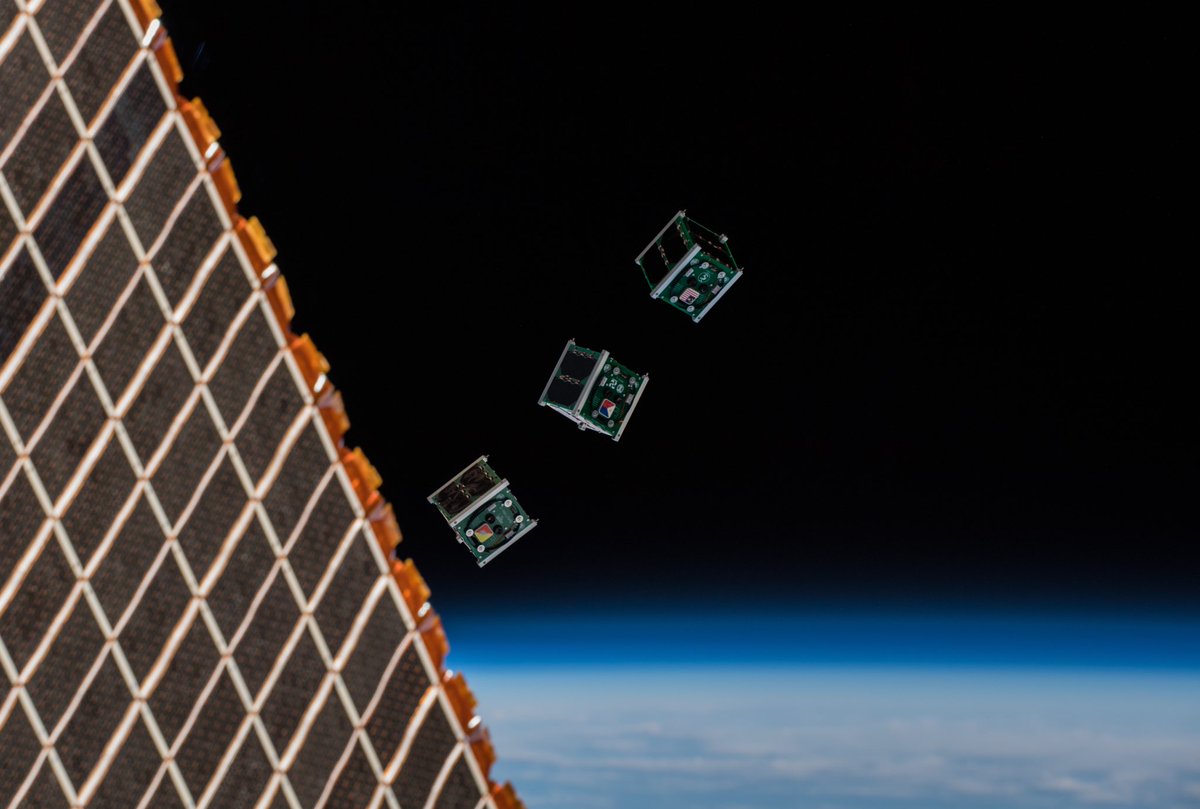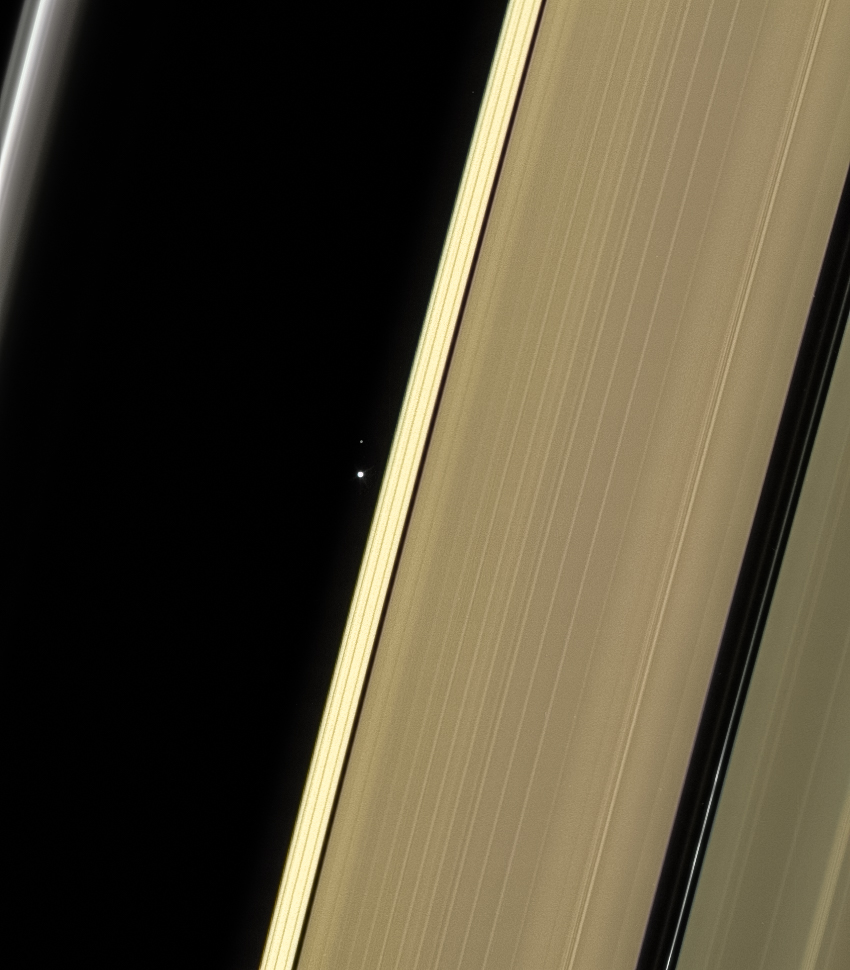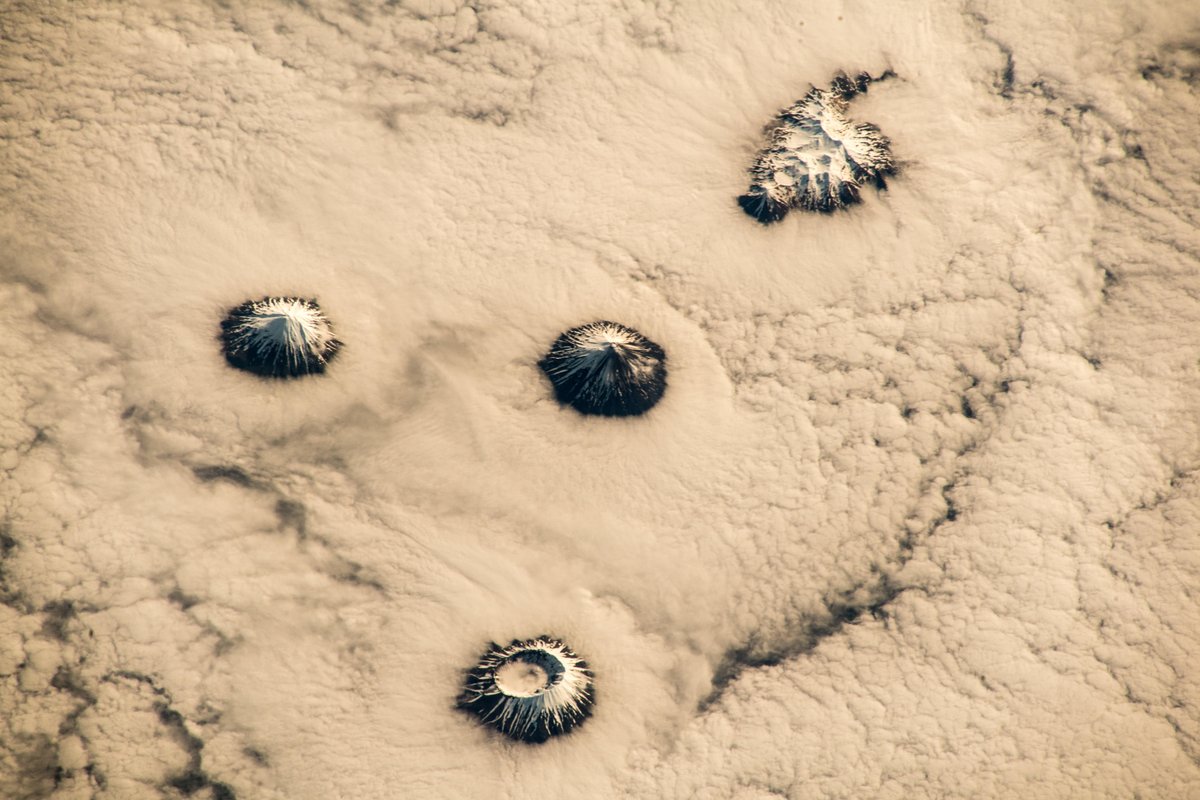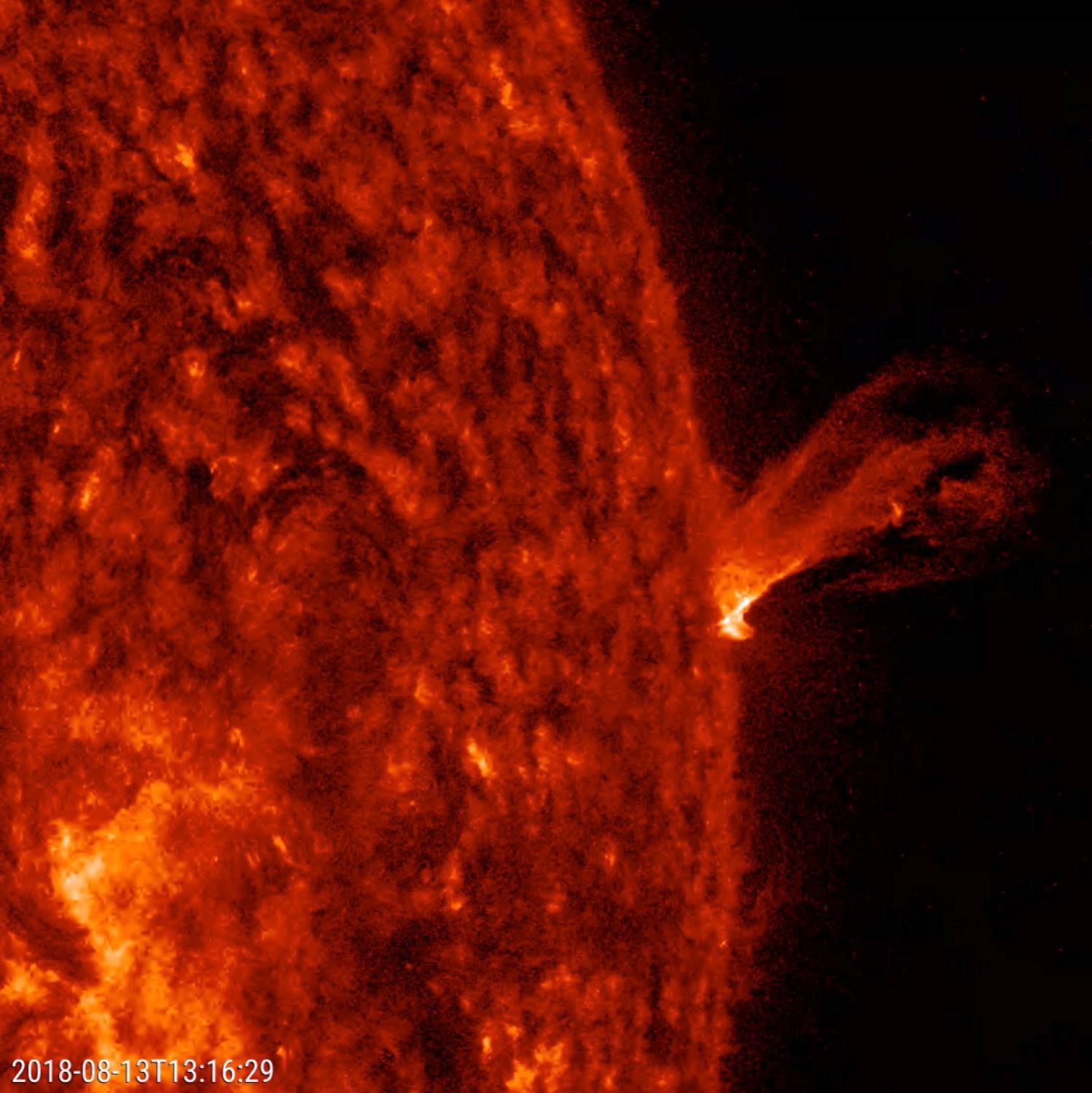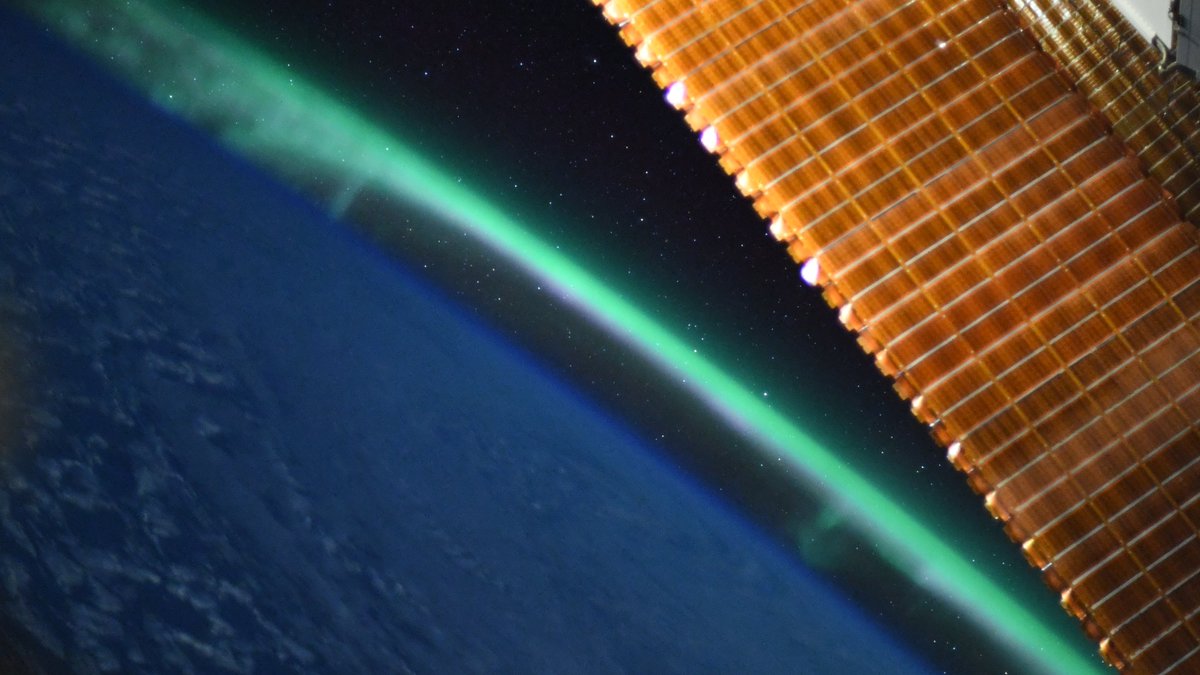Space Image of the Day Gallery (August 2018)
Three Cubesats Set Sail
Wednesday, August 15, 2018: Three identical cubesats belonging to three different Asian countries float above the Earth after Expedition 56 astronauts deployed them from the International Space Station on Aug. 10, 2018. One of these cubesats, named Bhutan-1, is Bhutan's first-ever satellite. The other two belong to Malaysia and the Philippines. If you look closely, you can see the countries' flags on the front of the cubesats. — Hanneke Weitering
Two Cosmonauts on a Spacewalk
Thursday, August 16, 2018:Russian cosmonauts Oleg Artemyev and Sergey Prokopyev took a spacewalk outside of the International Space Station yesterday (Aug. 15) to deploy four small satellites and install a new experiment called ICARUS, which will allow scientists to track baby turtles and other wildlife from space. — Hanneke Weitering
Earth and the Moon Photobomb Saturn's Rings
Friday, August 17, 2018: Earth and the moon play "peekaboo" behind Saturn's rings in this image from NASA's Cassini spacecraft. Citizen scientist Kevin Gill processed the image using data collected on April 13, 2017, about five months before the mission ended with a crash-dive into Saturn. — Hanneke Weitering
Milky Way and Cosmic Neighbors Sparkle Over La Silla
Monday, August 20, 2018: The colorful arc of the Milky Way curves over the La Silla Observatory in the Chilean Atacama Desert in this photo by European Southern Observatory (ESO) photographer Petr Horálek. Below the arc are the Magellanic Clouds, two of the Milky Way's neighboring dwarf galaxies. Jupiter glows big and bright on the right side of the image, just above the ESO 3.6-meter optical telescope. The shiny silver telescope on the left is the Swedish-ESO Submillimeter Telescope, which was decommissioned in 2003. — Hanneke Weitering
Happy Eclipse-iversary!
Tuesday, August 21, 2018: On this day in 2017, the Great American Solar Eclipse passed across the continental U.S., and astronauts could see it from the International Space Station. NASA astronaut Randy Bresnik took this photo of the moon's shadow, which briefly turned day into night for a 70-mile-wide (100 kilometers) stretch of land beginning in Oregon and ending in South Carolina. "It was an otherworldly sight to see this huge dark patch move across our planet from @Space_Station," Bresnik tweeted. "Looking upward was equally amazing as we caught it being blocked by the moon." — Hanneke Weitering
Sunken Volcanoes Seen from Space
Wednesday, August 22, 2018: The Kuril Islands, a volcanic archipelago northeast of Japan, pierce through a layer of clouds in this photo taken from the International Space Station by European Space Agency astronaut Alexander Gerst. "Sunken world of fire and ice," Gerst tweeted along with four photos of the snow-capped volcanoes. "The volcanoes of the Kuril Islands chain are an eerie reminder that our planet is far from being static." — Hanneke Weitering
Aeolus Takes to the Skies
Thursday, August 23, 2018: Europe's new weather-mapping satellite Aeolus lifted off from French Guiana yesterday on a Vega rocket supplied by Arianespace. Aeolus is the first satellite designed to map Earth's winds on a global scale. Ironically, the launch was delayed 24 hours from Tuesday (Aug. 21) due to strong high-altitude winds near the launch site. — Hanneke Weitering
Breaking space news, the latest updates on rocket launches, skywatching events and more!
'Twisting Outburst' on the Sun
Charged particles erupt from the sun in this close-up image from NASA's Solar Dynamics Observatory. The sun-monitoring satellite spotted the outburst on Aug. 13. During the eruption, the twisted stream of solar particles rose to a height that was "several times the diameter of Earth," NASA said. — Hanneke Weitering
Very Large Telescope Family Portrait
Monday, August 27, 2018: The Milky Way shimmers over six of the eight telescopes that make up the European Southern Observatory's (ESO) Very Large Telescope array in this fulldome view captured by ESO photographer Petr Horálek at the Paranal Observatory in northern Chile. A yellow laser beams into the sky to create an artificial star, or a "laser guide star," which helps astronomers correct for atmospheric turbulence or "seeing" when observing the cosmos. — Hanneke Weitering
Neon Auroras Seen from Space
Tuesday, August 28, 2018: A bright-green aurora shimmies above the Earth in this photo taken by Russian cosmonaut Oleg Artemyev at the International Space Station. When energetic particles from the sun enter Earth's atmosphere near the poles, they collide with molecules in the air to create colorful light displays. Artemyev recorded a video of this neon-green aurora, and you can watch it on Twitter. — Hanneke Weitering
Join our Space Forums to keep talking space on the latest missions, night sky and more! And if you have a news tip, correction or comment, let us know at: community@space.com.

Space.com is the premier source of space exploration, innovation and astronomy news, chronicling (and celebrating) humanity's ongoing expansion across the final frontier. Originally founded in 1999, Space.com is, and always has been, the passion of writers and editors who are space fans and also trained journalists. Our current news team consists of Editor-in-Chief Tariq Malik; Editor Hanneke Weitering, Senior Space Writer Mike Wall; Senior Writer Meghan Bartels; Senior Writer Chelsea Gohd, Senior Writer Tereza Pultarova and Staff Writer Alexander Cox, focusing on e-commerce. Senior Producer Steve Spaleta oversees our space videos, with Diana Whitcroft as our Social Media Editor.
